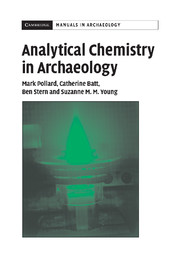Book contents
- Frontmatter
- Contents
- List of figures
- List of tables
- Preface
- PART I THE ROLE OF ANALYTICAL CHEMISTRY IN ARCHAEOLOGY
- PART II THE APPLICATION OF ANALYTICAL CHEMISTRY TO ARCHAEOLOGY
- PART III SOME BASIC CHEMISTRY FOR ARCHAEOLOGISTS
- 10 ATOMS, ISOTOPES, ELECTRON ORBITALS, AND THE PERIODIC TABLE
- 11 VALENCY, BONDING, AND MOLECULES
- 12 THE ELECTROMAGNETIC SPECTRUM
- 13 PRACTICAL ISSUES IN ANALYTICAL CHEMISTRY
- Epilogue
- Appendices
- References
- Index
11 - VALENCY, BONDING, AND MOLECULES
Published online by Cambridge University Press: 03 May 2010
- Frontmatter
- Contents
- List of figures
- List of tables
- Preface
- PART I THE ROLE OF ANALYTICAL CHEMISTRY IN ARCHAEOLOGY
- PART II THE APPLICATION OF ANALYTICAL CHEMISTRY TO ARCHAEOLOGY
- PART III SOME BASIC CHEMISTRY FOR ARCHAEOLOGISTS
- 10 ATOMS, ISOTOPES, ELECTRON ORBITALS, AND THE PERIODIC TABLE
- 11 VALENCY, BONDING, AND MOLECULES
- 12 THE ELECTROMAGNETIC SPECTRUM
- 13 PRACTICAL ISSUES IN ANALYTICAL CHEMISTRY
- Epilogue
- Appendices
- References
- Index
Summary
This chapter continues the introduction to chemistry, but focuses on the way in which atoms combine to form molecules. The concept of valency is introduced as “combining capacity”, but is then explained in terms of electronic orbital theory, leading into a simple explanation of chemical bonding. The three major types of chemical bond (ionic, metallic, and covalent) are introduced, followed by a discussion of the bonding between molecules (van der Waals', dipole–dipole, and hydrogen bonding). This leads into a description of the shapes of molecules. Further discussions of bonding are available in general chemistry textbooks, such as Brady and Hollum (1993) or Atkins and Jones (2002). The final section consists of an introduction to the naming and structure of organic compounds, and the various forms of isomerism in such structures. Again, further details on nomenclature and structure can be found in books such as Streitweiser and Heathcock (1985), and Brady and Hollum (1993).
Atoms and molecules
Rarely are the chemical elements stable as single isolated atoms. Almost all elements exist as discrete multiatomic atoms (e.g., gases such as O2, Cl2) or as larger multiatomic agglomerations such as crystals and metals. By definition, compounds consist of more than one atom combined in some way, either as discrete molecules (e.g., H2O), or as (effectively) infinitely large crystals such as NaCl. Thus most elements and all compounds have some form of bonding between constituent atoms.
- Type
- Chapter
- Information
- Analytical Chemistry in Archaeology , pp. 249 - 274Publisher: Cambridge University PressPrint publication year: 2007

